
|
|

September 21, 2007
Rochester's AM 950 (WARC/WBBF/WEZO/WROC)
Welcome back to another exciting season of Tower Site of the Week - and thanks for your patience during our busy summer travel schedule! We have one more trip still upcoming (North Carolina and Virginia, around the NAB Radio Show at the end of September), but we're excited about all the great tours we'll be sharing with you in the months to come. We'll take you to some big AM signals (WBBM, WSCR, KSL), some unusual arrays (how about an AM directional array with I-90 running right through the middle?), some prominent FM/TV mountaintops (Boise's Deer Point, Las Vegas' Mount Arden), not to mention the fields of Iowa, the FMs of Utica, and many more.
This week, though, we continue our look at some sites that are much closer to home - indeed, at one of the four AM sites that formed a cluster of towers near your editor's boyhood home (and his present residence, for that matter), helping to build his early interest in radio engineering.
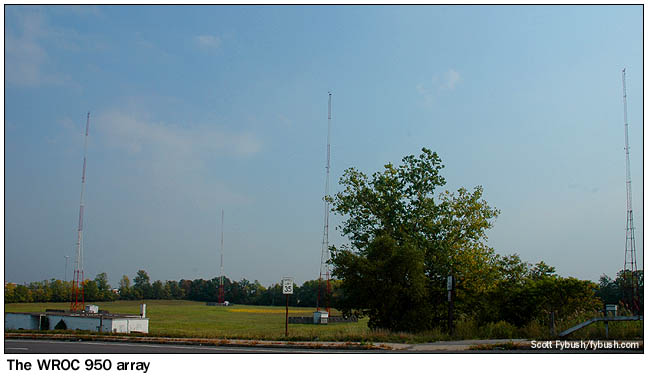
We've touched briefly on the AM 950 array in an earlier edition of Tower Site of the Week that provided a broad overview of this very special cluster of AM sites. But when we wrote that overview back in 2000, we'd (inexplicably) never been inside the 950 transmitter building - and as it turned out, we were missing most of what made this site special as a result.
The history first, of course: In the years just after World War II, the Rochester radio dial exploded, with three new stations joining the city's three existing stations - with two of those getting power increases and the third getting a new site. The second of the three new stations to make it on the air, as steel and copper and other building materials once again became available, was WARC (950), which claimed the ABC affiliation that had never found a home in the market (Rochester's established stations, WHAM and WHEC, had long ties to NBC-Red and CBS, respectively). For a downtown studio base, WARC found space in the Sagamore Hotel at 111 East Avenue, which had been the pre-war home of WHAM. And for a transmitter site, WARC looked south of Rochester, as more or less mandated by the need to protect established signals on 950 in Utica to the east, Detroit to the west and Philadelphia to the southeast.
WARC ended up with 1000 watts both day and night, with the day signal emanating from two towers arranged roughly east-west and the night signal using a three-tower in-line array with the north tower common to the day array. (In the photo above, looking east, the night array is in the foreground, with the daytime dogleg tower at rear left.)
Those 200-foot towers (they'd surely have been built to only 199 feet if they'd come along later, though the proximity of this site to the Rochester airport might still have forced lighting and painting) were positioned at what was then the extreme southern fringe of the Rochester market, along the Erie Canal about six miles south of downtown Rochester near the end of South Clinton Avenue.
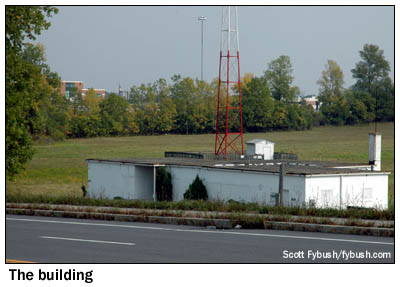
|
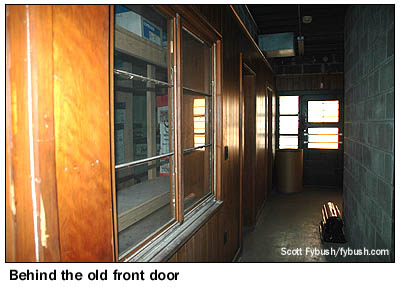
|
Remote as the site may have been back in 1947, it was still well-appointed. A newspaper supplement announcing the launch of WARC boasted about the state-of-the-art transmitter facility, complete with a glass-block entryway and Deco detailing.
As a directional station, the transmitter site had to be manned. And as with so many of those directional stations, the decision was made somewhere along the line to cut costs, employing DJs with first-class licenses to work night shifts from the transmitter site rather than employing both a jock at the downtown studio and an engineer at the transmitter.
I don't know whether that practice began in the WARC days, but it was most certainly employed during 950's next (and most famous) era. In 1953, the station was sold to the Forman family, owners of a prominent downtown department store, and the calls were changed to Mrs. Forman's initials - WBBF. (The first "B" stood for Bernice.)
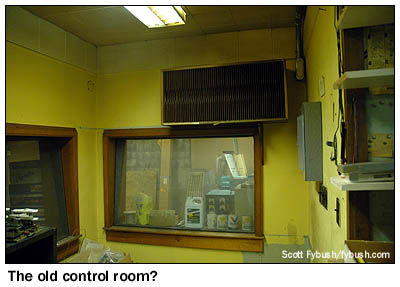
|
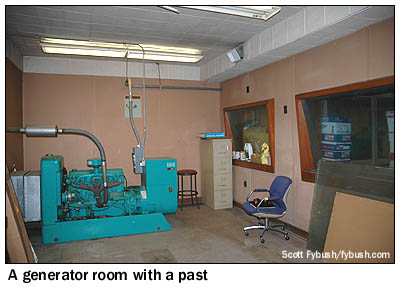
|
By 1957, WBBF had moved out of the Sagamore (by then Sheraton) Hotel and into new downtown offices at 339 East Avenue, but those were primarily sales offices. Most, if not all, of the programming was coming from Clinton Avenue, and the programming was rocking. WBBF was one of the earliest top 40 stations, and before long it was racking up immense shares of the market, back in the days when an AM station whose signal couldn't even make it to the county line could pull a 40 share by being the only top-40 outlet in town. (This was not unique to Rochester - WOLF in Syracuse and WYSL in Buffalo were other nearby examples.)
WBBF kept rocking for longer than most of the AM top 40 stations, surviving as late as 1982 before flipping to talk. By then, the studios were long gone from the transmitter site, having moved to the Midtown Plaza tower downtown in the sixties. The next quarter-century would not treat AM 950 kindly: it went through four owners (ending up today under Entercom) and multiple formats (talk, country, oldies, standards, oldies, then talk again), even changing calls in 1998 when the WBBF identity and oldies format moved to FM. From 1998 until 2000, 950 was known as WEZO, taking the identity of a defunct beautiful-music FM station (now WRMM 101.3), and while the WBBF calls came back from 2000-2002 in an oldies FM simulcast, the magic was gone. In 2002, the WBBF calls gave way to WROC as part of a licensing deal with WROC-TV (Channel 8) under which 950, now a talk station again, would carry simulcasts of Channel 8's news. (The WROC calls had a prior history on radio from 1961-1978, within sight of the 950 site, at the 1280 facility now known as WHTK.)
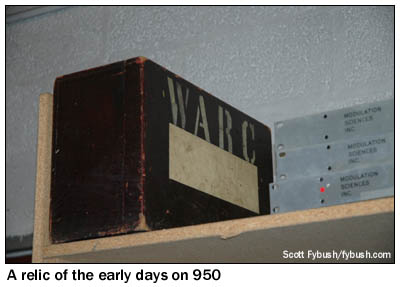
|
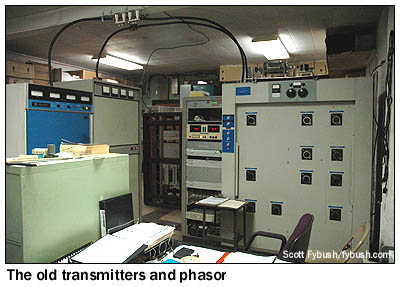
|
In the meantime, the site that had been so remote in 1947 had become part of inner-ring suburbia. The opening of the Outer Loop and Genesee Expressways (I-390/I-590) in 1980 not only helped fuel that sprawl, but also brought tens of thousands of drivers a day past the 950 transmitter site, which today sits just south and east of the ramp that carries northbound 390 traffic to northbound 590. Office parks replaced most of the farmland that surrounded the site, and a residential development is now being planned for the piece of land just east of the 950 site (which was itself an early site for 1280, but we'll get there in a later Site of the Week installment.)
WROC today is a progressive talk station, with all its programming fed by satellite to studios in the High Falls district downtown. Its signal reaches only part of the market clearly, especially at night, and it's a credit to Entercom that it's spent as well as it has to keep the site on the air and up to date. One enters the building now through the door at the south end of the building, not the old main entrance, and the first thing in sight is the 950 transmitter room, where a vintage Gates BC-1G keeps company with a Gates MW-1 that's fairly vintage itself. As the MW-1 began aging (becoming effectively a "MW-1/2," as the joke went), Entercom sprung for a new solid-state box in 2005. The Nautel J1000 shown below takes up only a few inches of rack space, but has received rave reviews from the engineering crew at 950.
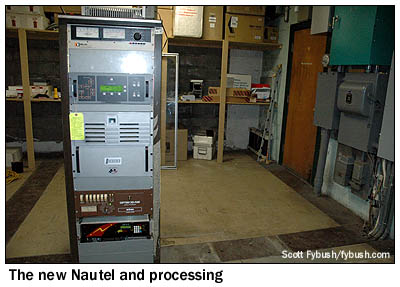
|
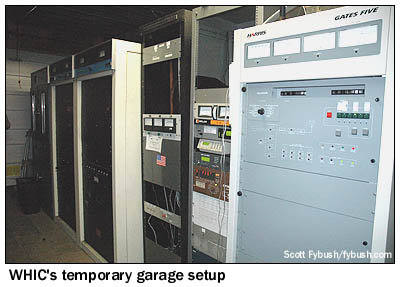
|
A raised area adjacent to the transmitters, behind the phasor, was clearly once the control room when 950 operated its studios here. There's still a "WBBF 950 KC" sign hanging above one window, and an old rack that once held LPs abover another. That studio looked into two other studios, a small one that's now used for storage and a larger one that houses the station's generator. The only sign of the WARC era still remaining is an old equipment case (a remote amplifier, possibly) that sits on one of the storage shelves in the transmitter room, probably untouched for decades.
And there's one more chapter to the story of this site, to be seen (for now) in one of the garage bays at the north end of the building, off the old main entrance.
When another of 950's neighboring stations, WHIC (ex-WHEC/WAXC/WWWG) 1460, lost its transmitter site in 2006, its initial plan was to diplex on the 950 site. Shortly before the old 1460 site on Winton Road was demolished, WHIC moved its transmitters into the 950 garage, diplexing into one tower of the array with (if memory serves) 4500 watts day, 750 watts at night, non-directional under Special Temporary Authority. A CP was issued to upgrade the night signal to 3000 watts, using the three 950 night towers, but for various reasons WHIC ended up looking elsewhere instead. It's completing construction on a new three-tower array in Henrietta, a few miles to the south, and before long the equipment now in the garage will be gone. (Only the Gates Five shown at right was ever in use from the 950 site; the old E.F. Johnson phasor and MW-5 that came over from the old site were simply in storage here.)
Tower Site Calendar 2008 is here! Visit the Fybush.com Store now and get your calendar before the price goes up next month!
- Previous Site of the Week: Rochester Radio City
- Next Week: Rochester's WLGZ 990
- Site of the Week INDEX!
- How can you help support Site of the Week? Click here!
- Submit your suggestions for a future Site of the Week!
